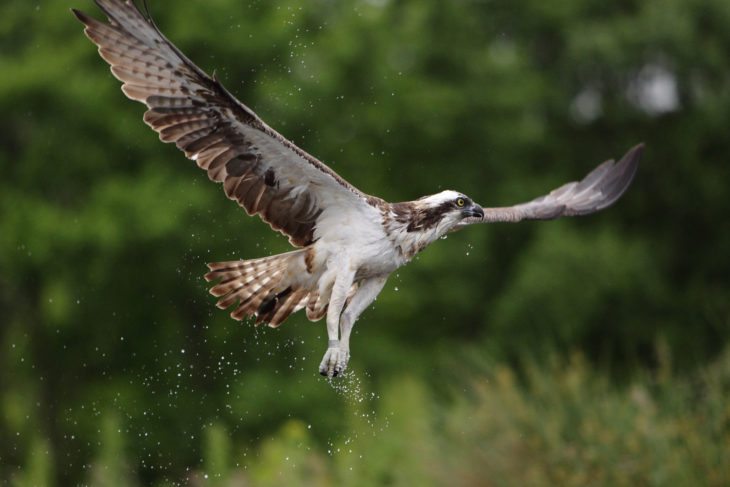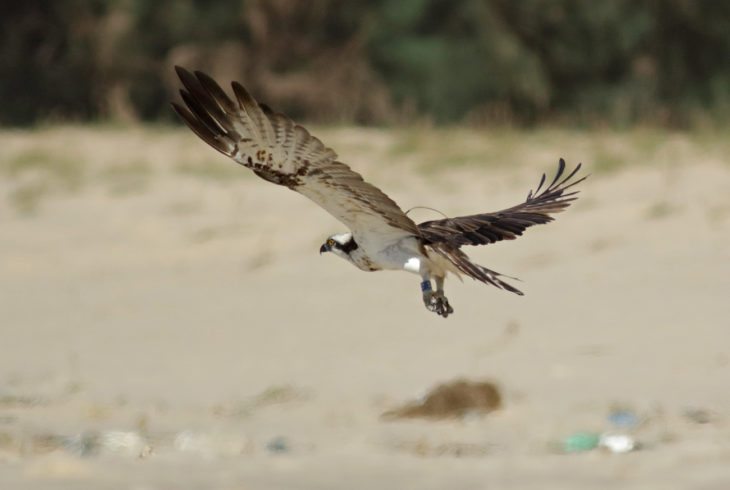Understanding osprey migration
Tracking satellite tagged osprey chicks has helped to reveal more about their lives after they leave Scotland. This guest blog by Ruth Crawford and Jed Long explains how data collected by the Scottish Wildlife Trust has led to a better understanding of osprey’s preferences for stopover and wintering sites.
The lives of Scotland’s iconic ospreys have captivated people of all ages for many years. During the breeding season the antics and adventures of ospreys at their nesting sites can be witnessed first-hand. However, previously little was known about the lives of individual Scottish ospreys once they had left for their autumn migration.

From 2012 to 2015, the Scottish Wildlife Trust, with help from Roy Dennis and Keith Brockie, fitted small GPS satellite tracking devices to a number of osprey chicks to help learn more about their habits outside of the breeding season. This allowed the ospreys to be tracked as they migrated across Europe to wintering sites in West Africa. The adventures of Blue YZ, Blue 44, Blue YD, FR3 and FR4 have been followed by many people from around the world on the Trust’s website.
In the final year of my Geography degree at the University of St Andrews I was lucky enough to have the opportunity to use the Trust’s data for my honours dissertation. My research project analysed the satellite telemetry data to explore the habitat preferences of these young Scottish ospreys at their stopover and wintering sites.
The research focuses on the stopover and wintering sites of the five young Scottish ospreys (Blue YD, Blue YZ, Blue 44, FR3 and FR4). Stopover sites provide important resting habitat for ospreys during migration, allowing them to refuel before the rest of their journey.
Stopover strategies vary between individual ospreys. For example, Blue YD and FR4 made no autumn stopovers, Blue 44 and Blue YZ stopped off in Europe and FR3 took two breaks (in France and Morocco) whilst on autumn migration.
Once they have arrived at their wintering sites in Western Africa, young ospreys like Blue YD can remain for several years before returning to Europe to breed. An understanding of ospreys at these sites is therefore important in informing conservation strategies.
Our research combines the Trust’s satellite tracking osprey data with freely available environmental data sets to explore habitat preferences and use of protected areas by the five young ospreys at their stopover and wintering sites. This is an interesting method that highlights how satellite tracking data can be used alongside other data sets and fieldwork to research migratory species that travel long distances.
The results of the project confirm already existing knowledge that ospreys prefer habitats close to water bodies (lakes, rivers and the ocean), allowing them to hunt for fish. However individual preferences for forest or open land cover varied between the young ospreys.
The juvenile ospreys avoided urban areas highlighting the importance of ensuring that suitable stopover and wintering habitat is preserved in the face of expanding human activities. At stopover and wintering sites, the young ospreys did not generally show a preference for protected areas. This may raise concerns as effective conservation will require the protection of ospreys and their habitats throughout their annual migratory cycle.

Our research investigates just five juvenile ospreys. However, it illustrates how satellite tracking data can be used alongside other data sets and fieldwork to provide a greater understanding of ospreys during their adventures away from Scotland. This important knowledge can help us to protect ospreys throughout their annual life cycle. This exciting research has been published in the British Trust for Ornithology’s Ringing and Migration journal.
Ruth Crawford completed her undergraduate degree in Geography at the University of St Andrews in 2015. Her dissertation on osprey migration was awarded the Edwards Prize for the top dissertation in geography. Ruth is now the Young Root’s Project Officer at The Conservation Volunteers in Manchester, a Heritage Lottery funded role. She engages young people with assisted learning needs in local conservation and natural heritage.
Help protect Scotland’s wildlife
Our work to save Scotland’s wildlife is made possible thanks to the generosity of our members and supporters.
Join today from just £3 a month to help protect the species you love.
Preface
Tracking satellite tagged osprey chicks has helped to reveal more about their lives after they leave Scotland. This guest blog by Ruth Crawford and Jed Long explains how data collected by …
